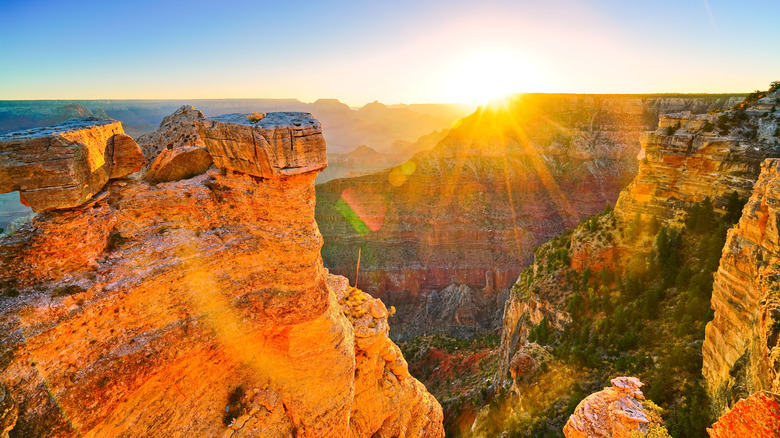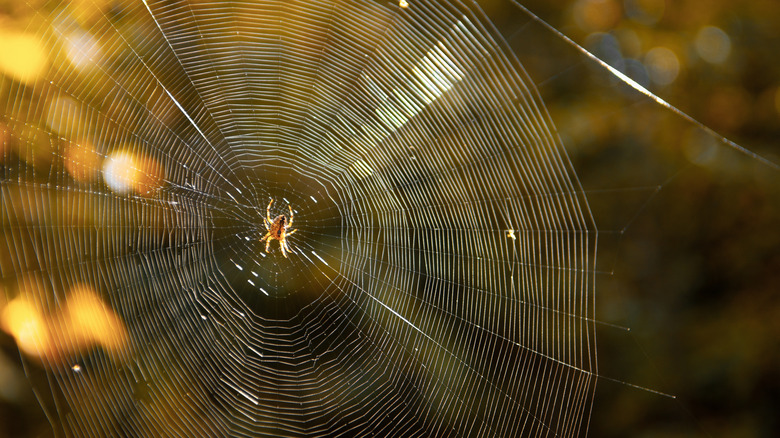The Hopi Creation Story Explained
The Hopi people are a Native American tribe who, today, mostly inhabit northeastern Arizona, where they have resided since approximately A.D. 500-700, according to Study. As one of the oldest living cultures in the world, they also have one of the oldest creation stories of all time.
In most of their creation stories, the first being ever to exist was Tawa, also referred to as Taiowa and Taawa, who was the sun god, per Native Languages. Some accounts say that Tawa created the world himself, according to New World Encyclopedia, while others say Tawa created a nephew called Sotuknang, whom the sun god ordered to create nine universes in accordance with his plan.
This version appears in a story told by Oraibi elders, per Railsback, which says that Sotuknang, the manifestation of the finite out of Tawa's infinite, was told to build the universe by gathering the water to make the sea and the air to make the winds. Sotuknang was also tasked with creating life to inhabit the worlds Tawa had designed, and so he created Spider Woman, who had the power to create life. Spider Woman sang the Creation Song and brought the first two living beings to life, which were twins, Poqanghoya and Palongawhoya, who were sent to the poles of the earth to balance out the planet, per Native Times.
The Hopi story of the first four worlds
According to the Oraibi story, singing her Creation Song, Spider Woman created all of nature, and then she created four women and four men, each of whom had soft spots in their foreheads that allowed them to hear the voice of their Creators, per Railsback. The people, who were given four different languages by Sotuknang, spread across the globe; however, their differences divided them, and most forgot the Creator. Sotuknang wound up destroying the world with fire, killing all but a few people who remembered the Creator, and who were able to take shelter underground with the ants.
Sotuknang then created a second world and ordered the people to remember their Creator, but the people in this world consumed too much and hoarded goods, and once again Sotuknang destroyed the world by freezing it, sending the few who remembered him to take shelter with the ants. The third world descended into war, and so Sotuknang destroyed it by flood.
Finally, the people who survived rose up from the earth, and Sotuknang sent them migrating across the land. Eventually the people settled in between the Colorado River and the Rio Grande, becoming the Hopi, who reside in a harsh landscape designed to remind them of their connection to their Creator.
Lessons of the Hopi creation story
There are many other versions of the Hopi creation story. Some stories describe a woman called Huruing Wuhti, or Hard Being Woman, who helped create the world, and others tell of Masauwu, or Skeleton Man, the alternatively grotesque and handsome master of the fourth world, according to New World Encyclopedia.
But every story highlights the importance of remembering the Creator. According to Bibliotecapleyades, when the people arrived in the fourth world, Sotuknang said, "I have washed away even the footprints of your Emergence; the stepping-stones which I left for you. Down on the bottom of the seas lie all the proud cities ... But the day will come, if you preserve the memory and the meaning of your Emergence, when these stepping-stones will emerge again to prove the truth you speak."
These words are reminders of the importance of preserving stories and maintaining connection to the land, which is growing increasingly visible as the world heats. Per Native Times, the Hopi creation story may be a story of climate change, and per The Hill, some believe we are approaching the end of the fourth cycle today.
As our ice caps melt, humans are being asked to "undergo a total change in attitude regarding life and the environment," according to Thomas Mails, per Celery Ellen. If it is the end of the fourth cycle, and if you take the end of the first three worlds as lessons, it seems humans are being asked to remember our connection to the Creator — and soon, lest we be swallowed by fire and floods as Sotuknang prepares to start the world anew.


